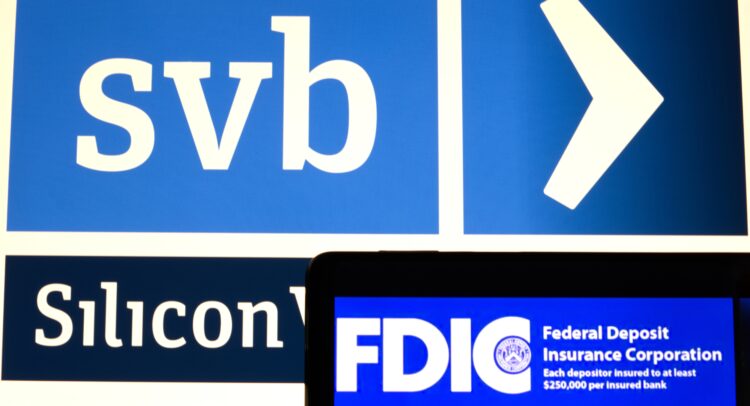On Friday, March 10, Silicon Valley Bank (SVB) collapsed after a run on deposits made the banks’ efforts to raise money and cover losses obsolete. SVB was closed and taken over by the Federal Deposit Insurance Corporation (FDIC). The second-biggest bank failure in U.S. history prompted regulators to impose emergency measures, such as making whole all of the bank’s customers – including the uninsured deposits – and providing a new lending facility for banks in need of liquidity.
Pick the best stocks and maximize your portfolio:
- Discover top-rated stocks from highly ranked analysts with Analyst Top Stocks!
- Easily identify outperforming stocks and invest smarter with Top Smart Score Stocks
SVB: The Endgame
Meanwhile, the regulators decide on its fate — whether SVB would be recapitalized, sold, or liquidated. SVB’s fate depends on the ability of the FDIC-appointed bank’s management to persuade its customers to come back, thus providing some value for a potential buyer. But the story doesn’t end with the failed bank, however important it was for the Silicon Valley startups and their VC investors.
SVB wasn’t a standalone bank but a main holding of a formerly esteemed large financial institution, SVB Financial Group, whose stock was a component of the S&P 500 index (SPX) up until this past Wednesday, a constituent of the NASDAQ Financial-100, and was also part of the Russell 1000 large-cap index.
Besides Silicon Valley Bank, SVB Financial (SVBFG) is composed of three other divisions: SVB Private, a private banking service affiliated with Silicon Valley Bank; SVB Capital, a venture capital and investment management subsidiary of SVBFG; and SVB Securities, an investment bank subsidiary of SVBFG. The group, founded in 1982 and spanning over 164 subsidiaries, reported that its total assets stood at $212 billion at the end of 2022.
Investor Wipeout?
As the memories of the 2008 financial crisis still haunt government officials and the general public, the authorities made sure to convey a clear message: no taxpayer money will be deployed, and only depositors will be bailed out, with shareholders left out in the cold. U.S. government officials conveyed a specific message for investors in the bonds and shares of SVBFG: they will be wiped out.
However, some of the holding group’s investors seem to hold other, fonder memories of the 2008 crisis, hoping to profit from SVB Financial’s demise. A swift reminder: Lehman Brothers was able to auction off its assets through bankruptcy in 2008, with buyers such as Barclays (NYCE:BCS) and Nomura (NYCE:NMR) snapping up different divisions of the fallen giant. Days before Lehman’s collapse, distressed bond investors bought heavily discounted Lehman bonds – and, in the end, went home with huge profits.
Bankruptcy Now
After Silicon Valley Bank’s failure, its parent company was not included in the bank closing or resulting FDIC receivership. On March 13, it began exploring a potential sale of SVB Capital and SVB Securities. By March 15, SVBFG’s management apparently ran out of “strategic alternatives” to explore, with bankruptcy filing coming into light as the most viable option.
In fact, after SVB’s closure, bankruptcy procedure was already on the table for the parent company. Of course, companies in such situations usually attempt to find investors to inject new money into the business or to find buyers for their healthier assets. However, this is a difficult task, as buyers are not protected by law if a company whose assets they’ve acquired files for Chapter 11 protection within a short period of time after the sale.
This caveat makes the purchase of distressed companies’ chunks too risky for most investors – especially as they know they can simply wait for the bankruptcy to unfold and then buy the assets free and clear of these risks in bankruptcy auctions.
“Vultures” Take Interest
Apparently, large institutional investors knew that the risks associated with the purchase of distressed assets would prevent SVB Financial from finding buyers for its businesses. Right after Silicon Valley Bank went belly up, these institutions began scooping up the parent company’s bonds for 30 to 40 cents on the dollar.
The large number of bets that the recovery value of SVBFG bonds will be higher than the market was pricing in led to a rise in their price to around 60 cents on the dollar by March 15 – still distressed, but in no way reflecting the imminent investor wipeout outlined by government officials.
The institutional buyers, which, according to media, include Goldman Sachs (NYSE:GS), Citigroup (NYSE:C), Oaktree Capital Management, Jefferies (NYSE:JEF), and others, acquired a large part of SVB Financial’s bonds over just a few days. The total face value of the group’s bonds on the market is $3.4 billion. Some of them, including Centerbridge Partners, Davidson Kempner, and PIMCO, even organized themselves into a group and reached out to a consulting firm, PJT Partners, for advisory services so that a bankruptcy of SVBFG works out as profitable for bondholders.
An Asset Firesale
It looks unavoidable that SVB Financial Group will be put into Chapter 11 bankruptcy, which would leave the group’s investors’ holdings subject to legal and financial procedures. While SVBFG shareholders are under no protection, the bondholders, aka creditors, will see some of their money from the asset sales.
According to the group’s latest financial report, it has a range of assets that could be used in bankruptcy to repay creditors, including a cash stash of above $2 billion, roughly $500 million in various investments, and, of course, the subsidiaries outside of the fallen SVB, such as the profitable SVB Private.
Stifel Financial (NYSE:SF) said in a note that the group’s creditors could get close to $4.75 billion in the event of liquidation if they recover all of the parent company’s non-bank assets, including cash and securities.
It should be noted that SVBFG may need to use part of the assets to cover Silicon Valley Bank’s losses (their amount is still under assessment) before it pays the bondholders. In addition, the FDIC will also want its part of the asset sale proceeds to recoup losses from the Deposit Insurance Fund.
If the sale of SVB Financial’s assets is conducted by the FDIC, the process would be hasty and the number of potential bidders minimal, thus limiting the amounts raised through the sale and leaving less money, if any, available for the bondholders. Creditors prefer that the assets are sold through bankruptcy since the number of buyers could be larger and there is more marketing of the assets, which leads to a much more profitable sale.
That’s why the investor group wants SVB Financial to file for bankruptcy and then sell its assets, unrelated to the now-defunct Silicon Valley Bank, under the supervision of a bankruptcy proceeding. They are arming themselves to make sure that the “wipeout” warnings not only don’t materialize, but the opposite becomes true: they want to book a large profit from the bankruptcy sale, just like Lehman’s bondholders did.



















